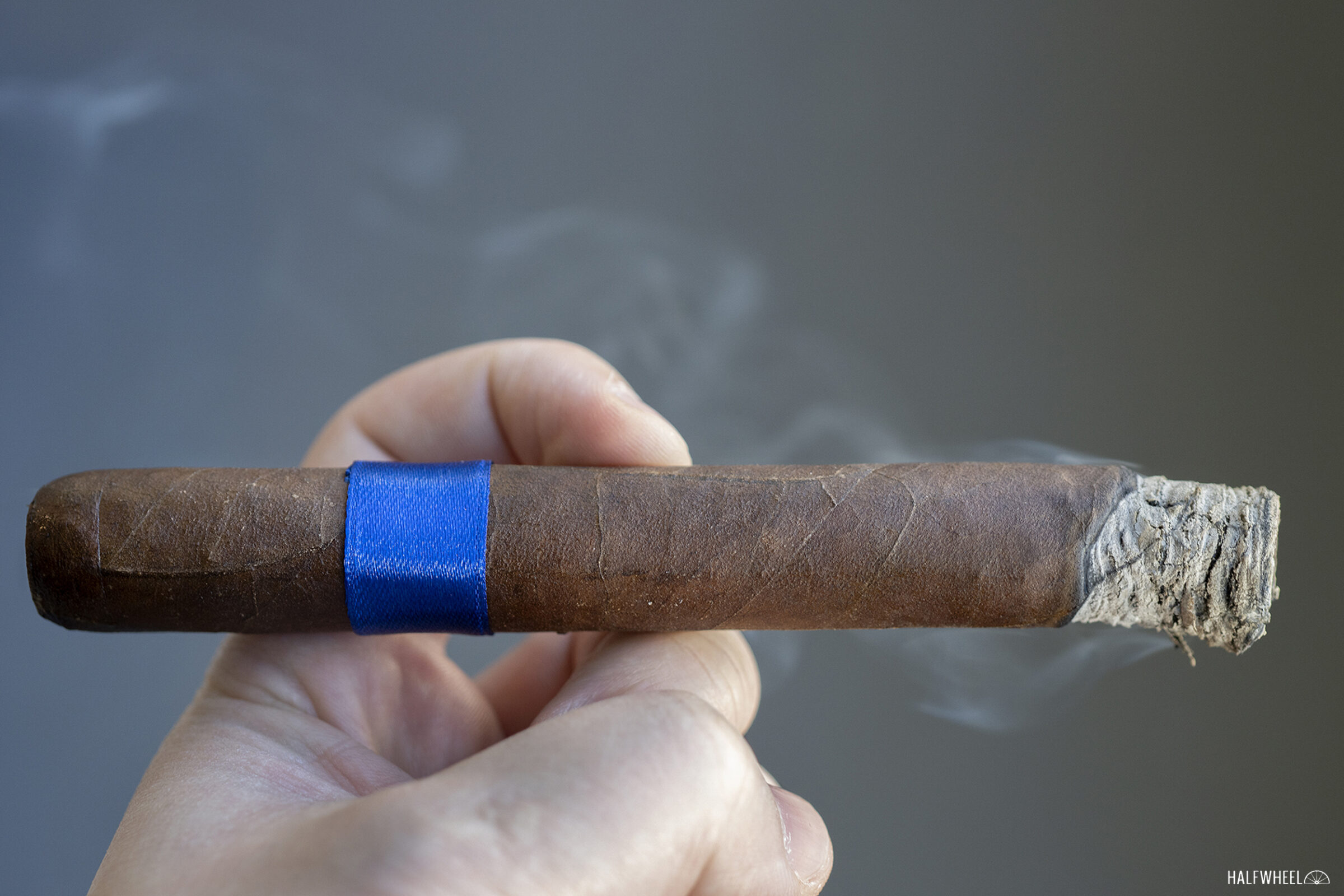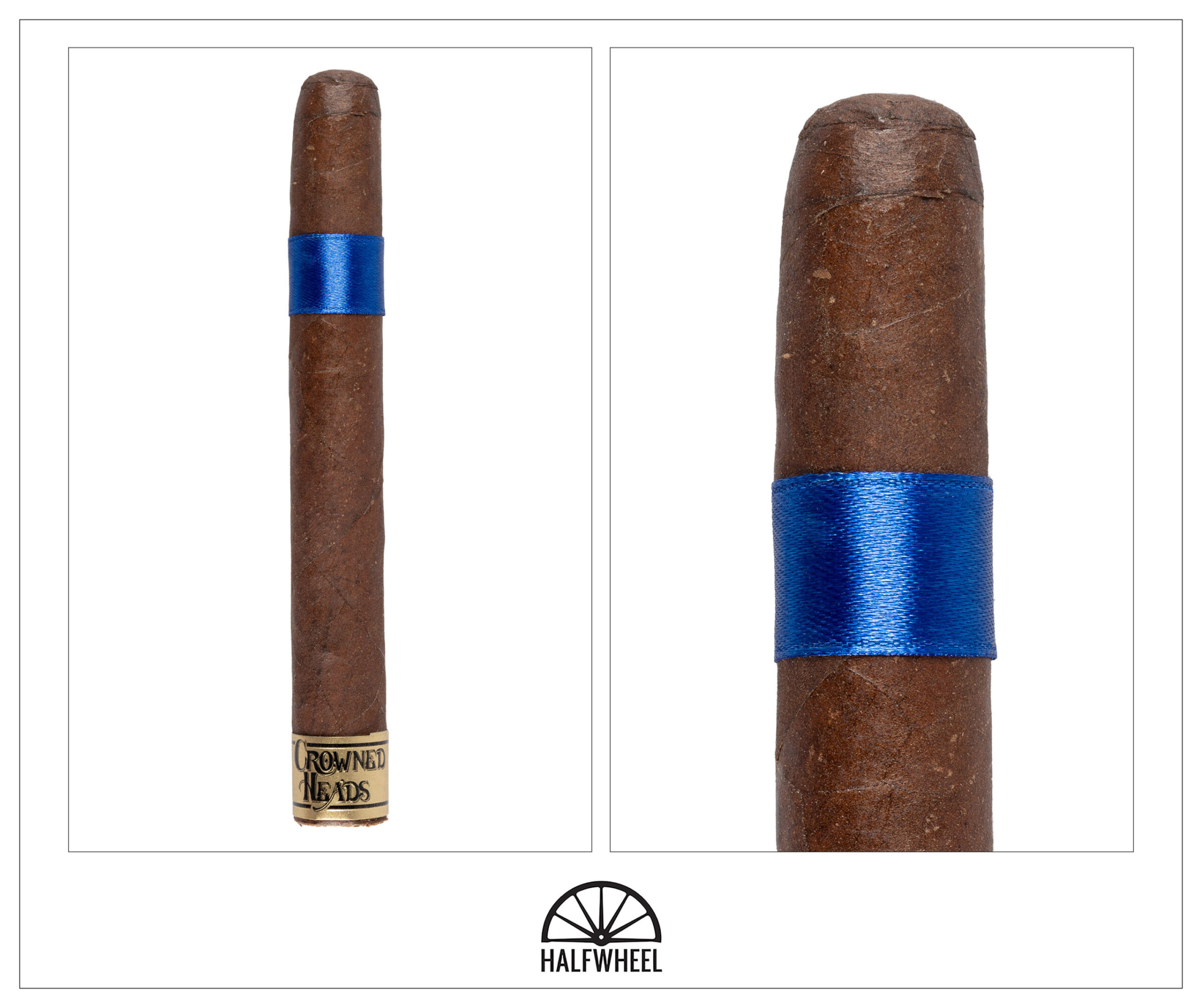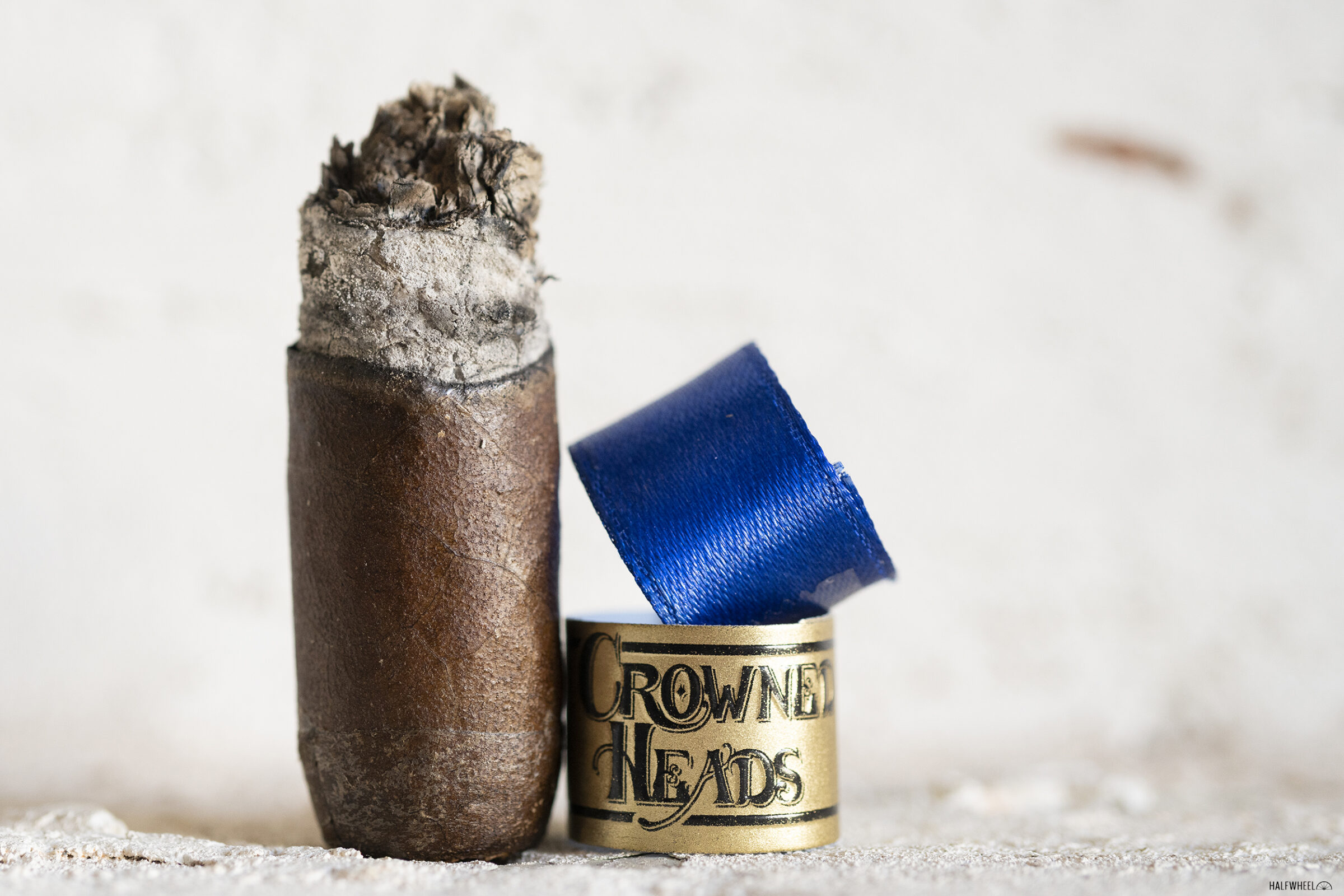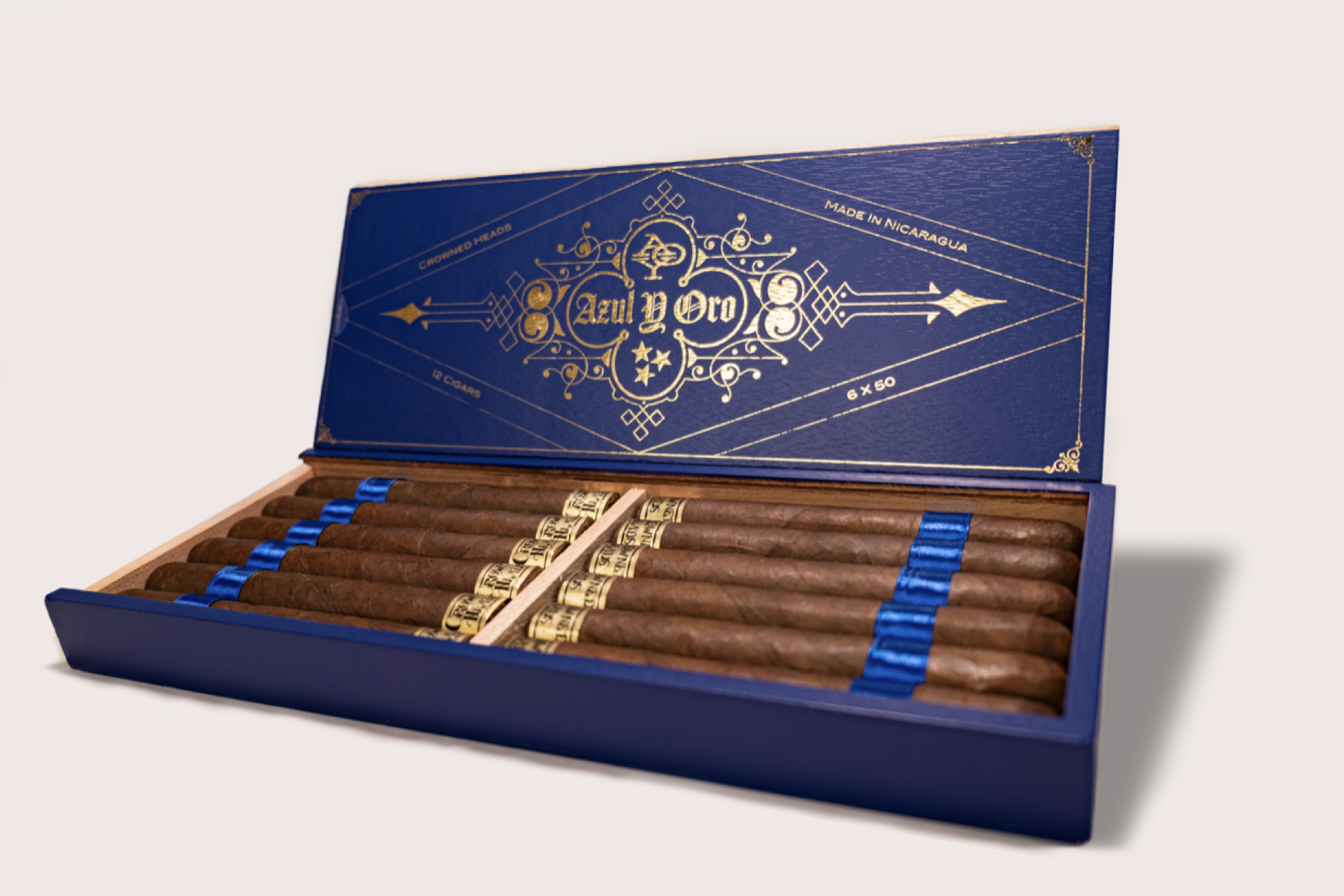In October 2022, Crowned Heads announced that it was moving production of its Le Pâtissier line from Tabacalera Pichardo—which made the original 2021 limited edition Le Pâtissier as well as the 2022 regular production version—to Nicaragua American Cigars S.A. (NACSA) in Estelí.
This marked the first time that Crowned Heads was working with NACSA, a factory that works with a number of other brands including Dunbarton Tobacco & Trust, Dapper Cigar Co., and Patina.
For its second release out of NACSA, Crowned Heads decided to use Johnny Walker Blue Label whisky as inspiration. As the story goes, when Crowned Heads’ founders Mike Conder and Jon Huber traveled to meet with Gustavo Cura of Oliva Tobacco Co. and NACSA, they gifted Cura a bottle of his favorite whisky: Johnny Walker Blue. So the second release is named Azul y Oro—Spanish for blue and gold—a reference to the colors used on the whisky’s label.
As for the cigar, it’s a 6 x 50 toro size that uses an Ecuadorian habano wrapper over a binder from Jalapa, Nicaragua and filler tobaccos from the Dominican Republic and three different regions in Nicaragua.
Unlike the current version of Le Pâtissier, this is a limited edition release with production capped at 2,500 boxes of 12 cigars.
- Cigar Reviewed: Azul y Oro
- Country of Origin: Nicaragua
- Factory: Nicaragua American Cigars S.A.
- Wrapper: Ecuador (Habano)
- Binder: Nicaragua (Jalapa)
- Filler: Dominican Republic & Nicaragua
- Length: 6 Inches
- Ring Gauge: 50
- Vitola: Toro
- MSRP: $11.95 (Box of 12, $143.40)
- Release Date: November 2022
- Number of Cigars Released: 2,500 Boxes of 12 Cigars (30,000 Total Cigars)
- Number of Cigars Smoked For Review: 3
I have not had Johnny Walker Blue in quite some time, but I’m pretty sure that the label is a darker blue than the ribbon used here. As for the cigar’s appearance, it’s a very consistent dark brown color that shows little in the way of vein structure. While each cigar has a very cylindrical shape, the foot of one cigar is smushed quite a bit, appearing almost box-pressed. The aroma from the wrapper has barnyard and ammonia as the two strongest flavors, though not in the most traditional sense. I find that the barnyard flavor is wider, though the ammonia seems to be more acute. Secondary flavors include acorns and sugar cookies. I would say there’s probably more going on, but the two leading flavors drown out a lot of the rest of the medium-full aroma. Smelling the foot reveals vanilla bean, barnyard, brown sugar and some acorns. It’s much more intertwined and balanced, though still medium-full. Cold draws have great resistance and flavors of chocolate accented by red pepper and oranges, there’s also a charcoal toastiness underneath that and then a flavor that reminds me of the core of an apple, neither as crisp nor sweet as other parts. Speaking to an earlier point, one of the strongest sensory experiences during the cold draw is the ammonia that I could smell from the wrapper.
The Azul y Oro starts with toasty earthiness, an English muffin-like flavor, earthiness, espresso and a mild chocolate sweetness. One cigar shows off a more terroir-forward version of the earthiness, though the first puff is pretty balanced on each cigar. A chewy nuttiness begins to slightly edge out the earthy flavors during the first third. As each cigar progresses, that earthiness shifts from a generic flavor to a more terroir-like flavor. Secondary notes include a butter-like creaminess, generic bread and a harshness that is at the front of my tongue, almost as if I’ve drunk something that is too hot. The finish has charred meats, bread and a pineapple-like tart sweetness. While not the strongest flavors, there’s mild amounts of vegetal and tart sensations that outlast the other flavors. Retrohales introduce even more nuttiness into the profile, probably because there’s less going on in the retrohale, though what flavors are present are stronger. Secondary notes include a generic earthiness, the terroir flavors, espresso, hickory and some soft cheese-like creaminess. The finish sees the terroir flavors take over and that harshness returns to the tip of my tongue. Flavor is medium-full, body ranges from medium-plus to medium-full, and strength is medium. Construction is a bit all over the place: one cigar needs a touch-up within five minutes of lighting, another needs a touch-up to help with an uneven burn, while the final cigar avoids any combustion issues in the first third. Additionally, one cigar has a tighter draw, while the other two are fine.
Terroir continues to increase its presence during the second third. Given the inspiration for this cigar, I feel the need to clarify that it’s not a peat flavor, though it’s certainly not generic earthiness. Secondary notes include toasted bread, espresso, multigrain bread, leather and some onion powder. There’s no letting up for the terroir during the finish, though it’s joined by some more mineral water-like flavors which changes the sensation a bit. In addition, there are herbal flavors, raspberry, black and green pepper and a familiar harshness towards the tip of my tongue. The largest changes are that the espresso flavors aren’t present during the finish and the flavors don’t pop as much compared to when they initially hit the palate. Retrohales continue with the terroir and mineral versions of earthiness, though sometimes I recognize a flavor that reminds me of an unripe strawberry. In addition, there are milder amounts of red and black pepper, though I find the harshness is a bit stronger than if I just use my mouth for puffing. The finish has a dough flavor that comes close to rivaling the earthiness, though it doesn’t fully get there. Again, harshness is more prominent than if I don’t retrohale, though one cigar has a flavor that reminds me of a very oily pepperoni. Flavor picks up to full, body is solidly medium-full and strength is now medium-plus. All three cigars need touch-ups to help with burn issues, oftentimes an uneven burn, and one cigar’s draw continues to be tighter than I’d like it to be.
While it may not be as strong as before, earthiness remains the star of the show with the mineral water-like version outpacing the terroir. Black pepper and bread have larger roles to play, though the profile as a whole is a bit more muted than before. The finish is similar with earthiness leading a generic cedar, white pepper, red pepper and a burnt tortilla-like toastiness. More than any other part of the Azul y Oro, I find the final third’s retrohale to have much more varied experiences. To little surprise, the earthiness is oftentimes the strongest flavor, though the other flavors can include cinnamon, white pepper, green pepper, bread, a milk-like creaminess and generic woods. While the retrohales are rarely consistent puff-to-puff, they are much more intertwined than earlier parts of the cigar. The finish varies as well, sometimes it’s an extension of the retrohale itself and other times it’s much more bitter, to the point where it tastes like I am chewing on a lightly-toasted slice of wheat bread that is too hot and decide to drink some milk to mitigate the burning in my mouth. Flavor is full, body is medium-full and strength is medium-plus. Two cigars require touch-ups in the final third, though the final cigar I smoke avoids any need for correction from my lighter.
Final Notes
- While I think Gustavo Cura has opened up a bit, I’ve always sensed that he prefers to work in the shadows and doesn’t want has name and face plastered on websites like these. Cura, who is the Nicaraguan operations manager for Oliva Tobacco Co., has many roles, but his office is inside Oliva Tobacco Co.’s Nicaprosa Procesadora S.A. (PROCENICSA) facility in Estelí. If you are in Estelí and need a bale of certain tobacco, Cura is a person you—and likely many others—will visit. If you are having issues with how your broadleaf is processing, go visit Gus. If you were to spend a day in Cura’s office, you are likely to see a handful of people from other cigar factories visiting him and the massive supply of tobacco that Oliva Tobacco Co. has.
- I believe that you are best judged by your peers. I am guessing that few people garner as much respect from cigar factory owners in Nicaragua as much as Cura. Whether it’s Nicaragua’s small factories or the country’s largest, the people who own and operate those factories regularly mention Cura.
- This is the second cigar I know of that is inspired in some way by Johnny Walker Blue, or at least it would appear to be. While I do not think Johnny Walker Blue was ever explicitly mentioned by Gran Habano, the Gran Habano Blue in Green has a lot of similar design traits to the label of Johnny Walker Blue.
- Technically, Crowned Heads didn’t specify that it was Johnny Walker Blue, rather, a press release described the whisky as “famous for its iconic blue label.” I suppose it could have been a reference to the older packaging of Glenfiddich 30.
- As for Johnny Walker Blue, I’m not the largest fan of whisky as a whole. It’s not that I don’t like it; it’s just that I’d rather spend my money and blood alcohol level on other types of liquor. When I do drink Scotch, I generally prefer more of the medium-full peated whiskies like Bruichladdich.
- While the label is not blue and gold, the tube that the Shielding Speyside 18 Year is packaged in is blue and gold. I enjoyed that bottle of whisky a bit too much.
- I found the ash to be generally quite firm, requiring more force than normal to remove a large chunk. That said, it does have a tendency to expand outward and then cause flaking. Looking down at the table after finishing the cigar, I’d describe it as an above-average mess.
- While neither as stark nor as early as say my experience in this recent review, there was a pretty clear point in the final third of each cigar where it no longer became enjoyable and the profile just degraded. I don’t hold it against the cigar, though I’d say this cigar isn’t a candidate for the finger-burning nub.
- Here is a picture of the aforementioned smashed foot.
- Cigars for this review were purchased by halfwheel.
- Final smoking time was right around two hours and 10 minutes. I noticed that the second half of the cigar burned a lot quicker than the first.
- Site sponsors Atlantic Cigar Co., Cigars Direct, Famous Smoke Shop and JR Cigar carry the Azul y Oro.
I feel like the bones of the Azul y Oro are pretty good, even if the score suggests there are issues. This is the type of cigar that gets nickeled and dimed on our scoresheet because of a multitude of minor construction issues, usually, the need to fix part of the cigar that isn’t burning. These are all fair criticisms of this cigar, as none of the three Azul y Oros I smoked could make it consecutive thirds without me finding that part of the cigar was no longer burning. That said, if I wasn't reviewing the cigar, I'm not sure I would have noticed the issues as much. I actually think the cigar does a decent job of delivering a whisky-inspired flavor, even if it’s not the most refined profile. Like a glass of whisky, there are some overarching, dominant flavor(s)—earthiness—and some harshness, but also a plethora of nuance.






